Building on past successes, Carleton continues commitment to sustainability leadership
As a new working group convenes to accelerate campus progress toward carbon neutrality, Carleton’s history as a leader in sustainability comes to the forefront.
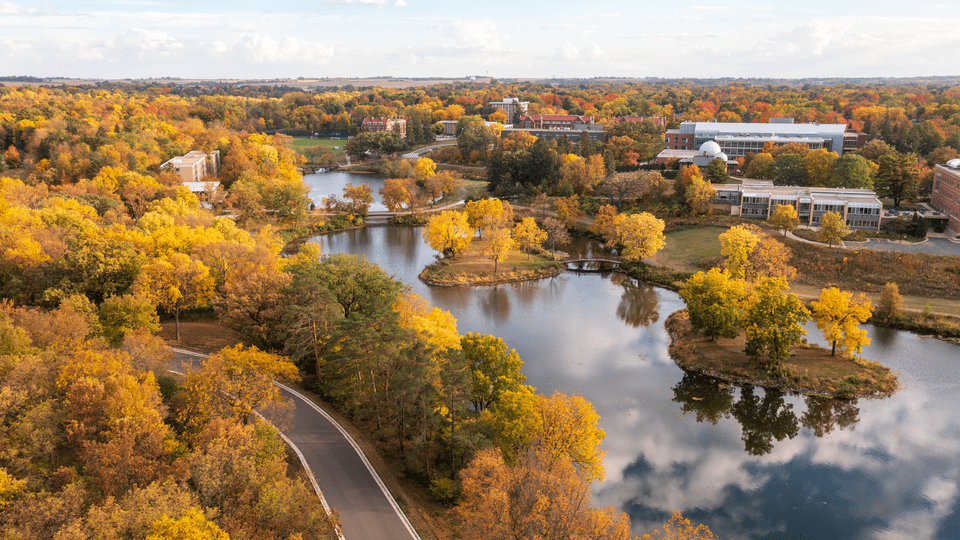
Carleton is embarking on a wholly new approach to sustainability that will build upon the college’s remarkable success in reducing its carbon footprint to accelerate progress toward carbon neutrality. The work of the new Sustainability Working Group, announced earlier this month, offers the opportunity for a reflection on and renewal of the college’s historic leadership in sustainability.
“This is an exciting time for sustainability at Carleton, with many important forces converging,” President Alison Byerly said. “The success of our innovative geothermal project has brought great visibility to Carleton, with many other colleges and universities looking to us as a model. Our rapid progress in reducing campus carbon emissions puts us on track to exceed the original expectations of our 2011 Climate Action Plan (CAP). The reconfiguration of the Office of Sustainability and appointment of a new director brings fresh energy and vision to our efforts. We are ready to move to a new level of environmental leadership.”
Reducing Carbon Emissions
According to a September 2021 report from Carleton’s Environmental Advisory Committee (EAC) following an extensive self-study, the college has far outgrown the initial goals set by the first CAP—for example, the commitment to becoming a carbon-neutral campus by the year 2050. Carleton has already exceeded both the 2025 and 2030 interim reduction milestones, with the EAC finding that there has been a 69% reduction in carbon emissions since the baseline year of 2008. A 2022 report from Reuters also lists Carleton as polluting at rates much lower than its local grid. In a graphic included in the report, Carleton is shown to have the lowest pounds of CO2 per megawatt production of all institutions studied.
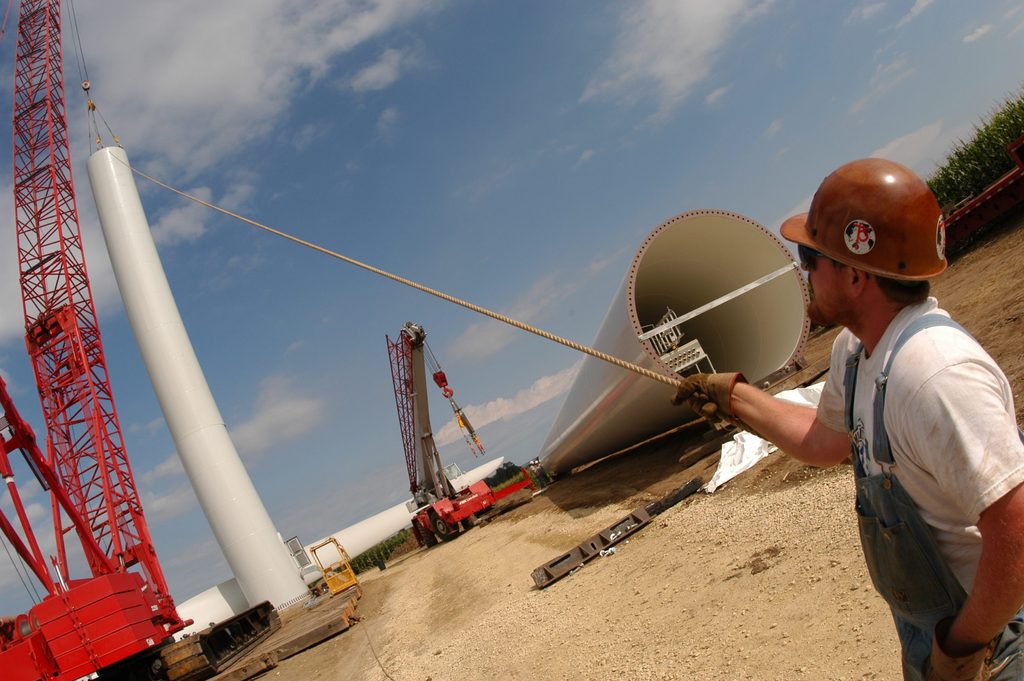
Two of the most recognizable symbols of Carleton’s work to reduce emissions are the wind turbines that stand about one mile east of the edge of campus. Carleton was the first higher education institution in the United States to install a wind turbine in 2004 and added a second in 2011. Together, the turbines provide over 50% of the campus’ electricity.
The more recently added geothermal heating and cooling system pushes Carleton’s progress toward carbon neutrality even further. The system has provided massive energy savings—in usage and cost—since the start of its implementation in 2019. The system’s ability to capture and repurpose existing heat reduced campus energy use by 50% in just the first year. Three 520-foot-deep geothermal bore fields on campus act like a giant thermal battery and reduce the need to create new energy at the central plant. Carleton has become a national leader among higher education institutions when it comes to this kind of energy, with the campus geothermal project winning NY-GEO’s Top Job award in 2022.

“We’ve seen a pretty dramatic drop in the use of natural gas since introducing the geothermal system,” Director of Facilities and Capital Planning Steve Spehn said. “We’re using less than half of the amount we were using before. The tradeoff for that is we knew electricity use would have to go up slightly, but we’ve actually seen a smaller increase in electricity use than we projected, which is great news. After spending two years planning and five years putting in the bore fields, creating a new energy station in Anderson Hall, and converting each and every building on campus to accept hot water power, it’s exciting to see tangible benefits coming from this project that has been such a huge part of our job in Facilities for so long.”
Energy Efficiency
Energy-efficient buildings are an important contributor to Carleton’s path to carbon neutrality, with one of the college’s most recent construction projects—the Integrated Science Complex, including the newly-built Anderson Hall and renovated Olin and Hulings Halls—earning the highest-possible Leadership in Energy and Environmental Design (LEED) Platinum ranking. The Weitz Center for Creativity and Cassat and James Halls are also top-rated by LEED, with the Weitz earning a Silver ranking and Cassat and James each earning Gold. Many older buildings on campus have also been retrofitted with LED lighting and other sustainable measures to be more efficient. When the Language and Dining Center was retrofitted for LED lights and controls, that decision alone saved 160,000 kWh/yr, which reduced the entire campus’ total electricity consumption by 1%.
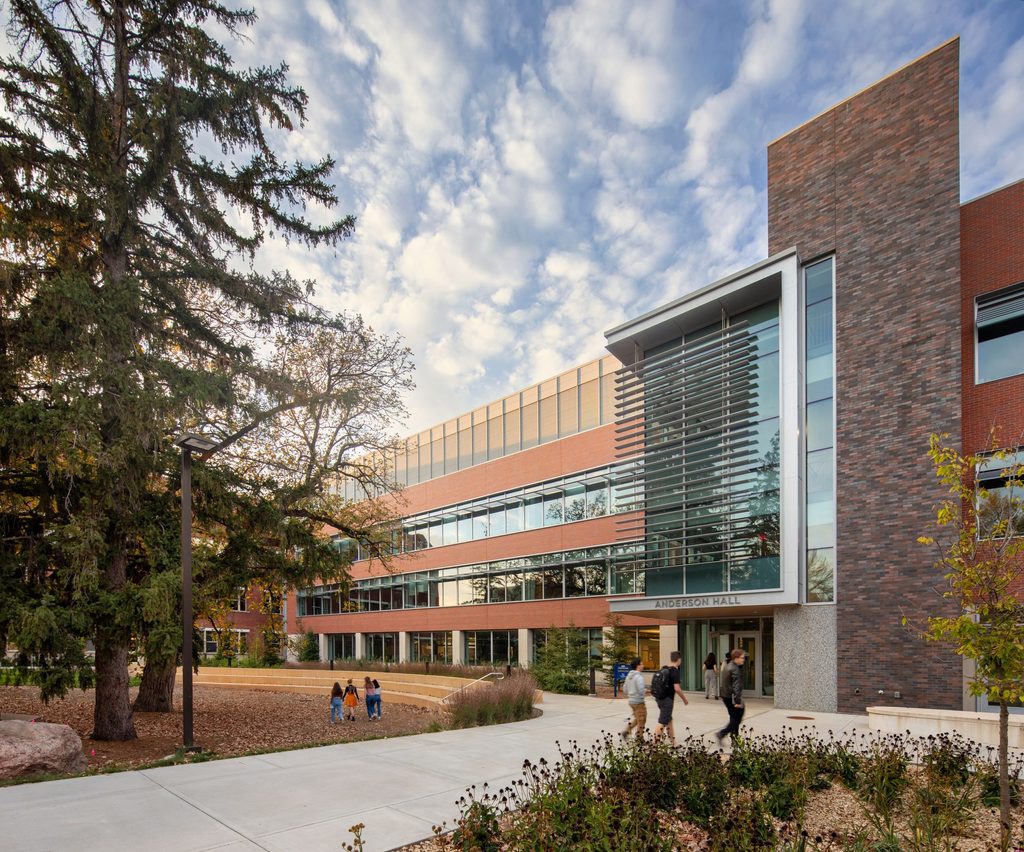
For future energy savings, new campus buildings proposed as part of Carleton’s Student Life and Housing Plan will be optimized for solar panels and built using Passive House Standards, meaning the buildings will require very little energy to achieve a comfortable temperature year round.
“We’re setting some really aggressive energy reduction goals and standards for new buildings,” Spehn said. “Our energy use goal is 15 kBtus per square foot per year. To put that in perspective, after the geothermal system was put in place, the average energy use on campus is about 56 kBtus/sf/yr. That represents almost a 70% reduction from current energy codes. We’re also aiming for net-zero energy use in at least one of the new sites through the combination of the Passive House Standards and solar panels.”
Along with Anderson’s Dark Skies Certified light fixtures and automatic shades that reduce light pollution—which new covered street lamps around campus help with as well—the Integrated Science Complex is especially notable for the incorporation of sustainable practices into its construction and demolition processes. Builders reused 76% of existing building materials in the renovation of Olin and Hulings, and recycled 95% of construction waste from the demolition of Mudd Hall, the building Anderson replaced. Anderson also consists of 35% recycled materials, 22% regional materials and 100% Forest Stewardship Council certified wood. Overall, the creation of the Integrated Science Complex increased total space by 33% yet decreased total energy use by 41%—32% of which is due to the switch to geothermal heating and cooling.
Food Production

According to the United Nations, about one third of all human-caused greenhouse gas emissions is linked to food. Carleton Dining Services therefore looks at every step in their food production process critically in order to help reduce Carleton’s part in that statistic. In partnership with the college’s contracted food provider Bon Appétit, Dining Services staff make sustainability and zero-waste a priority at every step of the food service process, from sourcing their ingredients from local and humane farms to using only reusable or compostable materials to serve their dishes. Bon Appétit has had a companywide commitment to buying locally through its Farm to Fork program since 1999—at Carleton, this commitment shows up in local food like turkey from Ferndale Market and produce from Open Hands Farm. These relationships with nearby farmers support local businesses and the local economy, improve the taste and nutritional quality of food available in the dining halls, and cut down on oft-unseen transportation emissions incurred by trucking in groceries from across the country.
Carleton Dining Services even works with the most local farm possible: the 1.5 acre Carleton Student Organic Farm on campus. Now permanently supported by an endowed fund started by geology professor emerita Mary Savina ’72, the farm provides thousands of pounds of fresh produce each year directly to the dining halls, helping keep Carleton more sustainable by cutting transportation emissions as well as using sustainable techniques like no-till farming. The farm is guided by a faculty advisor but run entirely by students, who take care of everything from planning to pricing to picking. In the summer, students can participate in the Student Organic Farm Internship, which is a full-time, paid position that lasts for 11 weeks. In addition to taking care of the farm, interns attend the yearly Midwest Organic and Sustainable Education Service (MOSES) Conference, the largest event about organic and sustainable farming in the U.S. which brings together over 3,400 farmers.
Waste Management

With food production comes some amount of waste, and the Carleton community strives to make that amount as small as possible through the college’s chapter of the national Food Recovery Network (FRN). Founded in 2014 by the Center for Community and Civic Engagement (CCCE) as the first in Minnesota, Carleton’s chapter of FRN is made up of student volunteers who recover surplus food from campus dining halls and retail stores in Northfield, ultimately transporting and redistributing it to local nonprofit organizations and schools that aim to reduce food insecurity in Rice County. FRN recovers about 1,500 pounds of food each week—during the 2018-19 school year, the group recovered over 100,000 pounds total.
Carleton also utilizes centralized waste stations across campus to ensure more efficient and sustainable waste disposal of all kinds, with each waste area split into three bins—landfill, recycle and compost—and each bin labeled with standardized “trash talking” posters depicting which kinds of waste go in each bin.
Student Leadership
The Sustainability Assistant (STA) program, made up of student employees in the Sustainability Office, was a primary contributor to the success of “trash talking” on campus. The STAs are divided into teams focused on outreach, environmental justice, waste, food, data and energy, and policy and transportation. Students passionate about sustainability at Carleton work on all kinds of projects throughout the year, including raising awareness during Climate Action Week, planting trees with the community during Northfield Earth Day, running educational workshops on energy and waste on and beyond campus, and guiding Carleton’s participation in the Real Food Challenge, which measures the percentage of campus food that is community-based, ecologically sound, humanely raised and fairly procured. Students like the STAs have always been vital representatives of forward momentum for sustainability at Carleton.

“My work as a STA has empowered me to develop innovative climate solutions for Carleton,” Beck Woollen ’23 said. “I help lead a committee of students and staff who are developing a local, peer-reviewed carbon offset project for the college. We’ve partnered with a local food shelf that diverts 300,000 pounds of food from the local landfill each year. By calculating the emissions savings associated with those efforts—and more specifically, Carleton’s contributions to that reduction—we anticipate being able to offset student air travel. It’s incredibly exciting to think about how in-house projects like this can contribute to our sustainability efforts moving forward.”
“So many Carleton students are engaged in campus and community problem solving for issues that intersect with the climate crisis, such as food security, health, affordable housing and more,” Director of Sustainability Sarah Fortner added. “They have just and sustainable development top-of-mind, which makes me so happy. Students often discover or invent the next action we should take to make progress. I love to learn from them!”
Reusing and Recycling

Carleton has multiple programs and events centered around reuse efforts on campus, many of them run by the STAs. The Office Supply Swap Shop, located in the Sustainability Office, provides the opportunity to drop off or pick up office supplies to prevent unnecessary purchasing or trashing. The Repair Fair is a community event pairing broken items with volunteer fixers to prevent those items from ending up in landfills. Free and For Sale Frenzy is a pop-up consignment shop that happens every term, organized by the STAs to promote more sustainable clothes shopping. Lighten Up, a large-scale event run by the CCCE, occurs at the end of each academic year, with students donating unwanted items at the end of spring term to be sold to local community members or students staying on campus over the summer during a massive “garage” sale. The event diverts 2.5% of Carleton’s total annual waste—equal to over 30 tons—from the landfill. With all proceeds going to local nonprofit organizations, Lighten Up 2022 generated over $37,000 for the CCCE to donate.
Working With Nature

Sustainability on campus even extends to animal residents like goats and bees. Carleton works with local business Goat Dispatch to hire goats from local farmers as cost-effective and sustainable tools for invasive species management every summer—the goats are safer and more eco-friendly than pesticides. Pollinator gardens are also scattered across campus, attracting bees and butterflies that in turn help out the Carleton Student Organic Farm and the Cowling Arboretum.
The Arb is integral to sustainability at Carleton, as part of its purpose is to protect and restore the area’s native ecosystems. Forest and prairie restoration work has been ongoing since the 1970s, with a program for invasive species eradication introduced in the 1990s. The Arb also serves primarily as an outdoor classroom for Carleton students, having been the subject of observational drawing courses, English natural history essays, and many biological and geological analyses, among other areas of study. In addition to student work, Carleton faculty engage with the Arb often in their scientific research and artistic practice. From archaeology and environmental studies to psychology and religion, the Arb is an important resource for all disciplines.
Links to Academics
The academic connection to sustainability is something the Sustainability Working Group is aiming to strengthen, especially in light of the new connection to the Office of the Provost through the reconfiguration of the Sustainability Office. Part of the power of a Carleton education is that it fosters the ability to create a more sustainable world, and a primary goal of the working group is to figure out ways Carleton can integrate sustainability into its curriculum at every level in order to strengthen that ability even more. In her role as director of sustainability and co-chair of the working group, Fortner is looking at the ways that other campuses have created value and recognition for sustainability curriculum and community engagement.
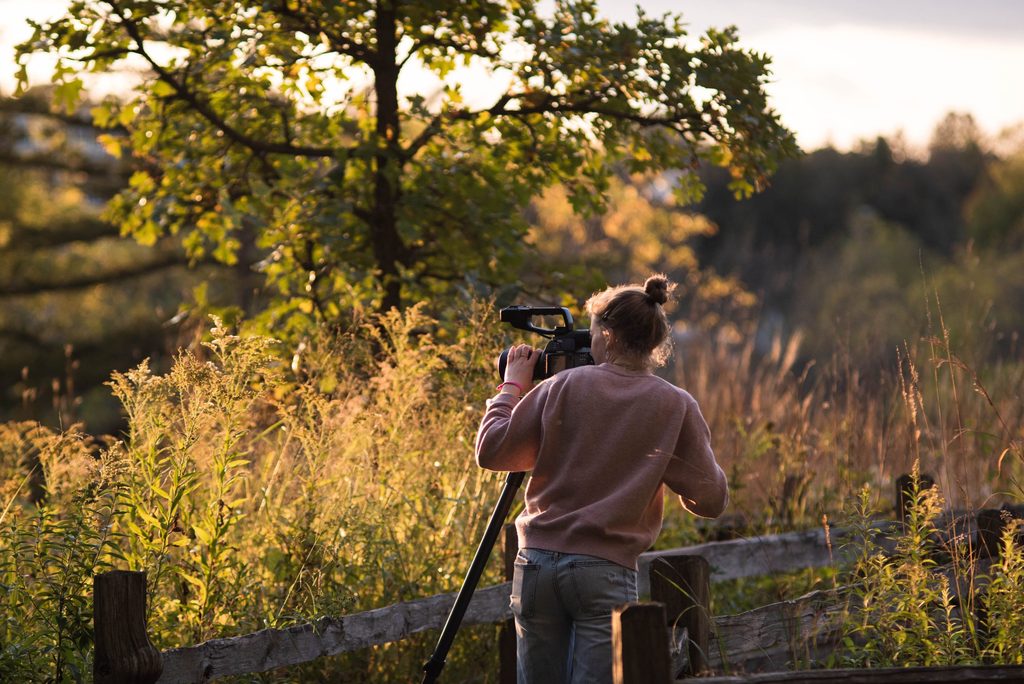
“One way colleges have scaled up sustainability curriculum is framing their work around the U.N.’s Sustainable Development Goals (SDGs),” Fortner said. “SDGs engage solutions to problems like poverty, hunger, climate change, unclean water, unaffordable energy, inequality and more, and are used to frame goals and activities at campus to international scales. I mention this example because Carleton’s curriculum already strongly features offerings in history, culture, gender, race, power, identity and more that are important to sustainable development. Many of these ideas have been historically left out of sustainability planning, which is a disservice to inclusive participation and just solutions. Whichever framework we choose to move forward with, we can show how a liberal arts education enables a better future.”
“As we launch the work on the Carleton 2033 strategic plan, it feels fitting to think about how we can support the work that others have started,” Provost and Vice President for Academic Affairs Michelle Mattson added, “including the initiatives that relate to the physical operation of the college, the environmental studies program and our work with community partners in Carleton’s intersecting community spaces. Sustainability is a comprehensive area to which all of our fields of study can contribute, and to which all of us can individually commit ourselves.”
Nationwide Networks
The college’s sustainability efforts won’t stop at forging campus connections—informed by Carleton’s national-scale work with the Science Education Resource Center (SERC) and a desire to collaborate broadly, many stakeholders, including the Sustainability Working Group, are looking to go further than that.
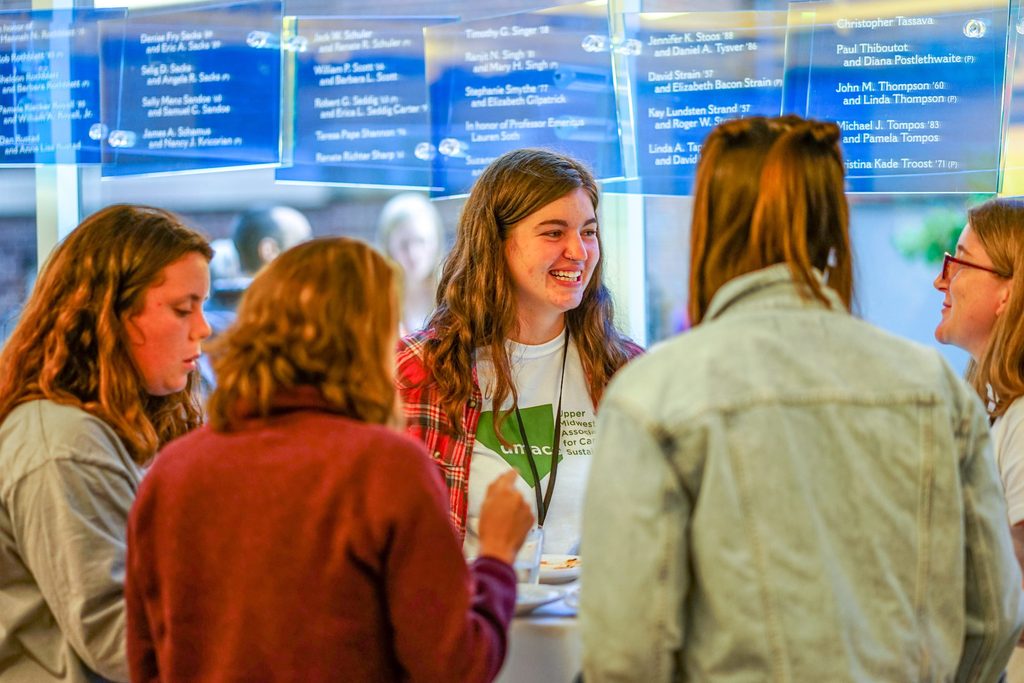
“We are interested in building action networks beyond campus,” Fortner said. “The emerging model for campus sustainability is creating synergies between a campus and its local community. This will be an important first focus, but I think we might dream a little more, even—envisioning Carleton as part of something bigger. For example, how do we unite across educator networks to address Midwest sustainability challenges? Or how might liberal arts campuses best collaborate across state lines to support sustainability outcomes? Creating wider networks will help us broaden participation and empower perspectives from places that have been historically left out of climate and sustainability efforts.”
A Sustainable Future
Carleton will not only continue the work it started in 2004 with the construction of the first campus wind turbine, in 2010 with the creation of the Sustainability Office, and in 2011 with the formation of the first Climate Action Plan; it will progress further and faster, and extend beyond campus as alumni take their sustainability knowledge and skills with them after they graduate.
“It’s a great time to grow into adaptation and environmental justice work, because there are many funding and political levers that support it now. There is also a wonderfully diverse mix of STEM, humanities and public engagement expertise amongst Carleton students, faculty and staff to identify and move forward initiatives in robust ways,” Fortner said. “By expanding education efforts, Carleton will directly support the culture and strategies needed to do sustainability work at all scales—on campus and off.”
Erica Helgerud ’20 is the news and social media manager for Carleton College.